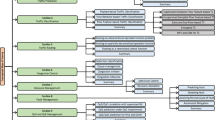Abstract
Among different researches on Wireless Mesh Networks (WMN), the Cross-layer Handling Link Asymmetry (CHLA) scheme has been enhanced with QoS-based Congestion Avoidance using Congestion Aware Routing (QSCACAR) technique. In this approach, QoS requirements were achieved by estimation of signal strength, network capacity, MAC scheduling, link scheduling and slot assignment. In addition, congestion was controlled based on the bandwidth management mechanism which is according to the congestion window on the dynamic traffic conditions. Based on these approaches, congestion over the network was controlled. However, the congestion window size was not precisely adjusted and selected by using these approaches. Therefore in this article, CHLA-QSCACAR is enhanced by including adaptive congestion window size based on the machine learning algorithm (CHLA-MQSCACAR). In this approach, congestion window size is predicted for adjusting the congestion in the next transmission. The Support Vector Machine (SVM) algorithm utilizes the congestion balance status as label and congestion control parameters as input attributes. Initially, congestion balance status of different transmissions and their corresponding input congestion control parameters are gathered. The collected database is trained with aid of SVM classifier. Then by using the trained SVM model, the congestion status of current transmission with congestion window size is predicted. The predicted congestion window is utilized for achieving congestion balance for the consecutive transmissions. Finally, the experimental results show that the performance effectiveness of the proposed CHLA-MQSCACAR compared to the existing CHLA-QSCACAR method in terms of different metrics such as routing overhead, bit error rate, end-to-end delay, throughput and latency.








Similar content being viewed by others
References
Le, L.: Multipath routing design for wireless mesh networks. In: Global Telecommunications Conference (GLOBECOM 2011), IEEE, pp. 1–6. IEEE (2011)
Zhuoqun, X., Zhigang, C., Hui, Y., Ming, Z.: An improved MPTCP in coded wireless mesh networks. In: Broadband Network & Multimedia Technology. IC-BNMT’09. 2nd IEEE International Conference on, pp. 795–799. IEEE (2009)
Becke, M., Adhari, H., Rathgeb, E.P., Fa, F., Yang, X., Zhou, X.: Comparison of multipath TCP and CMT-SCTP based on intercontinental measurements. In: Global Communications Conference (GLOBECOM), IEEE, pp. 1360–1366. IEEE (2013)
Dreibholz, T., Adhari, H., Becke, M., Rathgeb, E.P.: Simulation and experimental evaluation of multipath congestion control strategies. In: Advanced Information Networking and Applications Workshops (WAINA), 2012 26th International Conference on, pp. 1113–1118. IEEE (2012)
Huang, Y., Yang, X., Yang, S., Yu, W., Fu, X.: A cross-layer approach handling link asymmetry for wireless mesh access networks. IEEE Trans. Vehicular Technol. 60(3), 1045–1058 (2011)
Yuvaraj, N., Thangaraj, P.: An extended cross layer approach handling asymmetry with quality of service, congestion avoidance and congestion aware routing. J. Comput. Theor. Nanosci. 15, 1–9 (2018)
Carofiglio, G., Gallo, M., Muscariello, L.: Optimal multipath congestion control and request forwarding in information-centric networks: protocol design and experimentation. Comput. Netw. 110, 104–117 (2016)
Jiang, X., Jin, G.: Adaptive low-priority congestion control for high bandwidth-delay product and wireless networks. Comput. Commun. 105, 44–52 (2017)
Le, T.A.: Improving the performance of multipath congestion control over wireless networks. In: Advanced Technologies for Communications (ATC), 2013 International Conference on, pp. 60–65. IEEE (2013)
Maleki, E.N., Mirjalily, G.: Fault-tolerant interference-aware topology control in multi-radio multi-channel wireless mesh networks. Comput. Netw. 110, 206–222 (2016)
Priscoli, F.D.: A control based solution for integrated dynamic capacity assignment, congestion control and scheduling in wireless networks. Eur. J. Control. 16(2), 169–184 (2010)
Shailendra, S., Bhattacharjee, R., Bose, S.K.: Improving congestion control for concurrent multipath transfer through bandwidth estimation based resource pooling. In: Information, Communications and Signal Processing (ICICS) 2011 8th International Conference on, pp. 1–5. IEEE (2011)
Yoon, W., Lee, D., Shin, B., Han, S.Y.: Price-based congestion control and local channel-link assignment for multi-radio wireless mesh networks. Comput. Electr. Eng. 40(2), 651–662 (2014)
Liu, K.M., Fan, Y.Y., Liu, Y.A., Fu, H.: Congestion control algorithm based on congestion level and data rate for concurrent multipath transfer in wireless mesh networks. In: Wireless Communication and Sensor Network: Proceedings of the International Conference on Wireless Communication and Sensor Network (WCSN 2015), pp. 128–137 (2015)
Patel, B.I., Jadeja, A.: Congestion control technique for wireless mesh networks. Int. J. Adv. Cloud Comput. Comput. Sci. 1(2), 40–45 (2015)
Khasawneh, F.: Mobility management and congestion control in wireless mesh networks. Doctoral dissertation, École de technologie supérieure, Université Du Québec (2017)
Ngadi, M.A.B., Ali, S., Abdullah, A.H., Khokhar, R.H.: A taxonomy of cross layer routing metrics for wireless mesh networks. EURASIP J. Wirel. Commun. Netw. 2012(177), 1–16 (2012)
Mingheng, Z., Yaobao, Z., Ganglong, H., Gang, C.: Accurate multisteps traffic flow prediction based on SVM. Math. Probl. Eng. 2013, 1–8 (2013)
Raj, J.S., Harikumar, R.: A localized computing approach for connectivity improvement analysis in wireless personal networks. Wirel. Pers. Commun. 72(4), 2867–2883 (2013)
Raj, J.S., Harikumar, R.: A dynamic overlay approach for mobility maintenance in personal communication networks. Peer-to-Peer Netw. Appl. 7(2), 118–128 (2014)
Harikumar, R., Raj, J.S.: Ad hoc node connectivity improvement analysis—Why not through mesh clients? Comput. Electr. Eng. 40(2), 473–483 (2014)
Author information
Authors and Affiliations
Corresponding author
Rights and permissions
About this article
Cite this article
Yuvaraj, N., Thangaraj, P. Machine learning based adaptive congestion window adjustment for Congestion Aware Routing in Cross Layer Approach Handling of Wireless Mesh Network. Cluster Comput 22 (Suppl 4), 9929–9939 (2019). https://doi.org/10.1007/s10586-018-2357-y
Received:
Revised:
Accepted:
Published:
Issue Date:
DOI: https://doi.org/10.1007/s10586-018-2357-y




